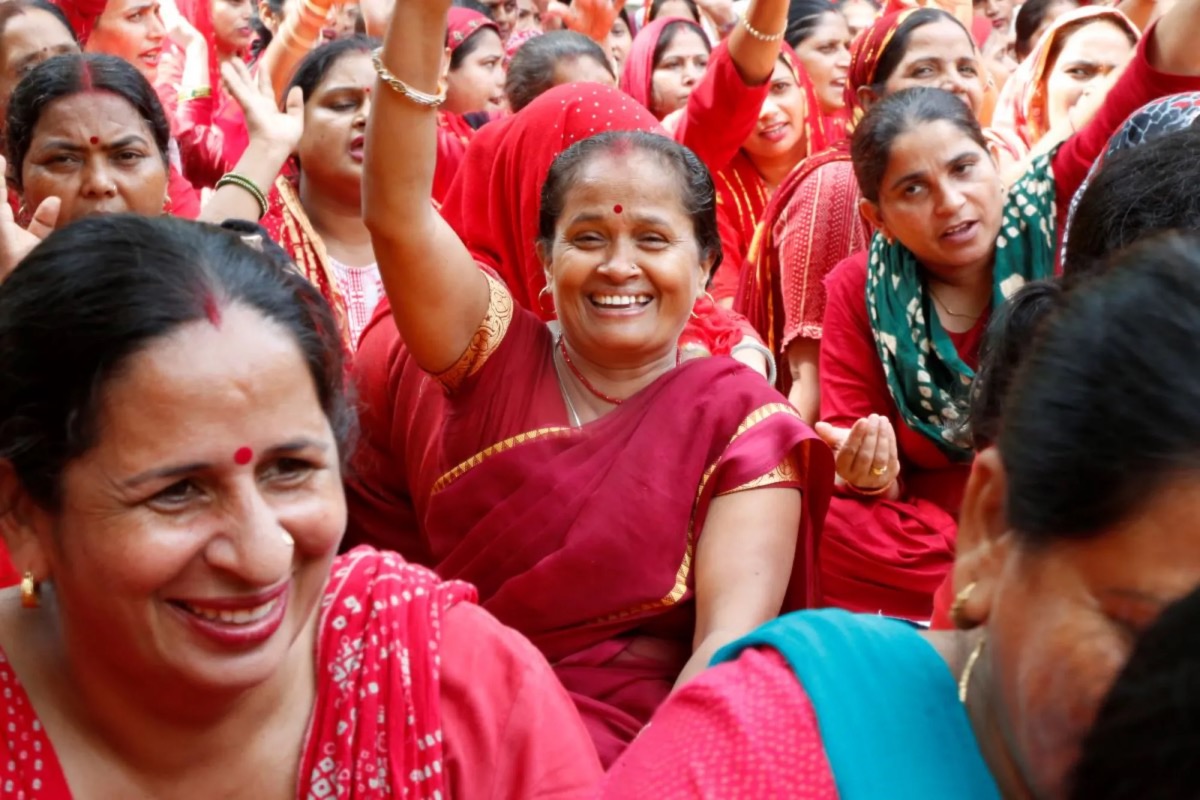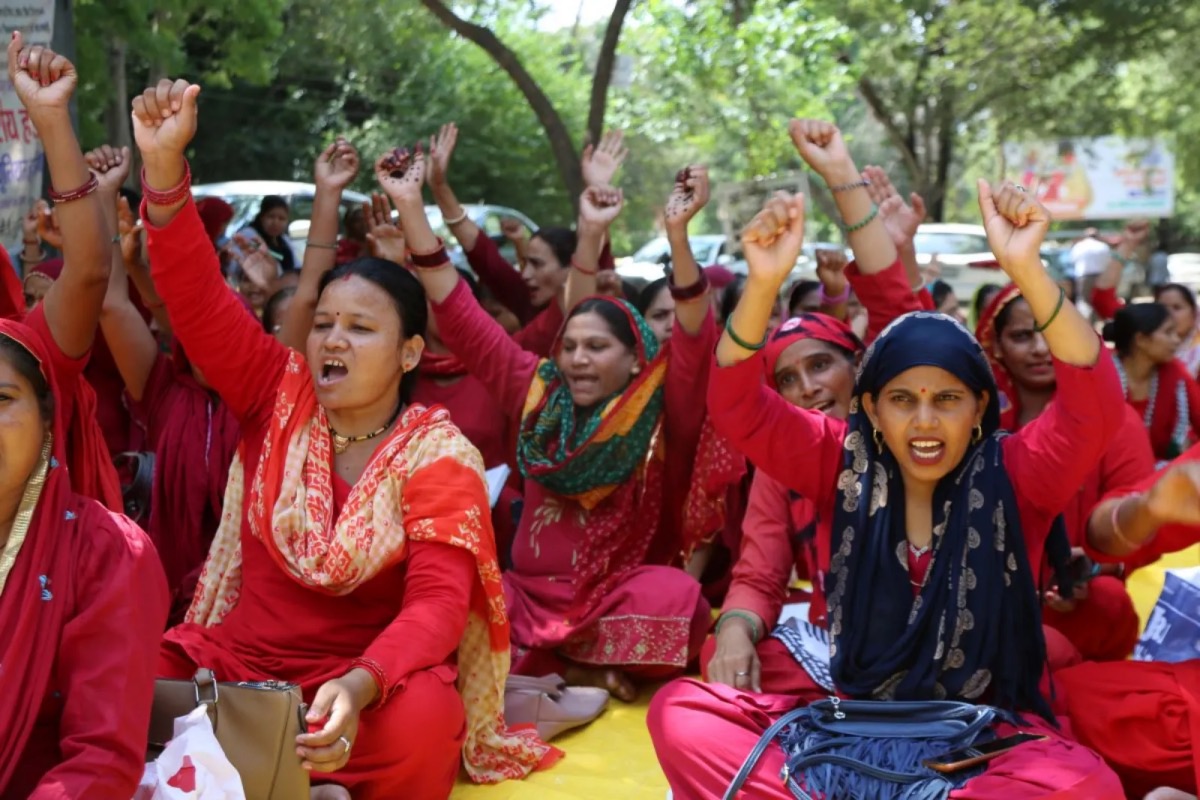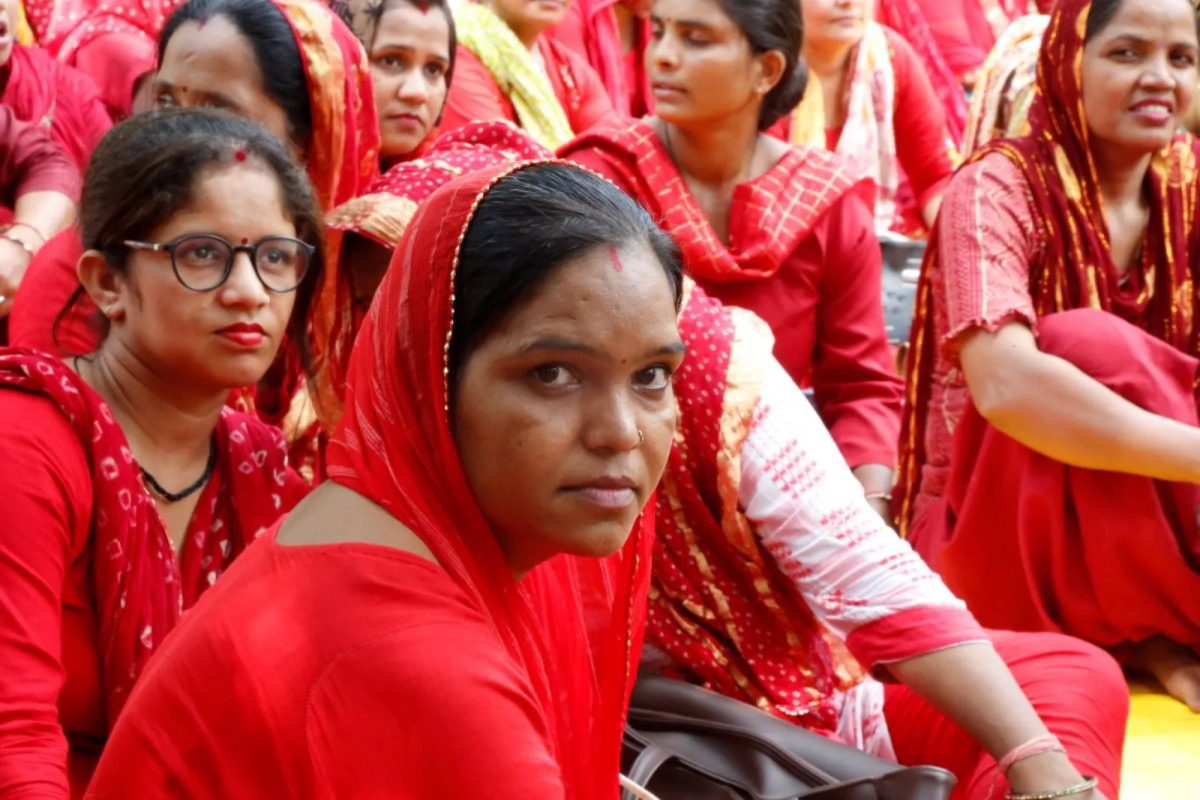
From India to Pakistan and Nepal, thousands of low-paid rural community health workers are demanding higher wages and labour rights. ANNIE BANERJI, ZOFEEN T EBRAHIM and AADESH SUBEDI, of Thomson Reuters Foundation, report…
Gurugram, India/Karachi, Pakistan/Kathmanud, Nepal
Thomson Reuters Foundation
Hobbling out of a tuk-tuk, Pooja Gupta joined fellow community health workers as they punched their fists in the air and chanted slogans against authorities in India who, they say, pay poorly despite giving them more and more work to do.
Like Gupta, tens of thousands of female health workers across South Asia are demanding basic rights and social protections that are currently denied to them such as the minimum wage, sick leave, maternity benefits and pensions.

Community health workers punch the air with their fists during a protest in Gurugram, India, on 19th September, 2023. PICTURE: Thomson Reuters Foundation/Annie Banerji
“We work nonstop. Woman in labour at midnight? Run to her. Injured child? Tend to them…We break our backs for our communities but we get nothing in return,” Gupta told Context during a protest last month outside an administrative office in the northern Indian state of Haryana.
“We are exploited and mistreated,” said Gupta, who has a torn ligament in her right leg, which makes her door-to-door job painful but draws little sympathy from her supervisor.
She said surgery would cost at least 75,000 Indian rupees ($US900) – nearly 20 times of what she makes in a month.
Gupta, 39, is one of more than a million Accredited Social Health Activists – or ASHA workers – who are usually the first point of contact in mostly rural India, where there is often limited access to healthcare facilities.
Many members of this all-women workforce have been on strike in different parts of India since early August, mainly demanding formal job contracts so they can receive a salary and employment benefits.
“We are exploited and mistreated.”
– Pooja Gupta
Currently they are treated as volunteers who receive allowances and incentives, and are not covered by state governments’ minimum wage legislation.
The Haryana state and federal health ministries did not respond to several requests for comment.
More than 20,000 ASHAs in Haryana are demanding their monthly pay be increased from 4,000 rupees to 26,000 rupees to reflect their growing list of responsibilities – from conducting surveys on different diseases and substance abuse to helping families get on a public health insurance scheme.
“It is impossible to survive on this money. Why do we always have to beg for basic things?” said Sarita Devi, a widow with three children, who depends on gifts of money, food and clothes from the families she helps.
“Without them, I would not be able to feed or educate my children.”

Community health workers punch the air with their fists during a protest in Gurugram, India, on 19th September, 2023. PICTURE: Thomson Reuters Foundation/Annie Banerji
The situation is similar elsewhere in the region.
Female health workers in India, Nepal and Pakistan released a joint “Charter of Demands” in August via global union Public Services International to call on governments and international agencies to recognise and uphold their rights.
“It’s extraordinary that they can’t make that small amount of budget available, and it just shows the disregard for the work these women do. Investing in them should be a no-brainer,” said Kate Lappin, Asia secretary at PSI.
Lappin urged big funders such as the World Bank and the Asian Development Bank (ADB) to back the women, who often face grave dangers – from violence to extreme heat, floods and landslides exacerbated by climate change – when serving their communities.
“Primary health is a huge economic benefit,” she said.
Balika Subedi, a 55-year-old health worker who earns 400 Nepalese rupees ($US3) a day in Nepal’s midwestern Pyuthan district, said she wanted to be paid a higher monthly salary with extra benefits such as fixed work hours and pension cover.
“I have climbed steep hills on scorching sunny days and through heavy downpours to deliver health services,” said Subedi, adding that a lack of transport options means she often walks days without food and water to reach remote villages.
“But the compensation that we are provided for our effort is very low.”
While Lady Health Workers’ in Pakistan are recognised as formal government employees, receiving guaranteed salaries instead of stipends, they also have complaints.
They say they want regular pay hikes commensurate with their experience, full healthcare cover, paid sick leave and maternity entitlements among others.
“We have never said no to any work or protested that our workload has increased,” said Bushra Bano Arain, chairperson of the All Pakistan Lady Health Workers Union.
“What we want is to be treated fairly and given what is due to us.”

Community health workers sit in protest to demand the government for better pay and benefits in Gurugram, India, on 19th September, 2023. PICTURE: Thomson Reuters Foundation/Annie Banerji
None of the three countries or individual provinces and states have officially responded to the demands so far.
Indian Prime Minister Narendra Modi lauded ASHA workers – who are behind a series of high-profile health campaigns, including India’s COVID-19 response and vaccination drive – last year after the World Health Organization gave them an award for their “outstanding contribution” to public health.
“Without them, the entire system would have collapsed,” said Sona Mitra, principal economist at Delhi-based IWWAGE, an organisation that works to boost the economic prospects of women and girls.
We rely on our readers to fund Sight's work - become a financial supporter today!
For more information, head to our Subscriber's page.
Mitra said that the returns to the society from ASHAs’ work far outweighed the meagre economic cost in regularising them.
“Care is emerging as a sector which is actually a super employment generator for women, and it is also a facilitator for other women,” she said.
“If the government does not have resources, it should…lure the private sector and show them that this is an attractive sector where their positive returns to investments, and there is a need for investments.”
Campaigners warn that the health of women and children would suffer the most without community health workers, as demonstrated by their recent walkout.
The strike meant Lata, a 24-year-old woman from Haryana’s Karnal district, could not reach her “ASHA Didi” (big sister) when she experienced a uterine rupture in late August two weeks after giving birth by caesarean.
“I was in so much pain. I didn’t know what to do without her,” Lata, who goes by one name, said by phone.
“I kept calling, but her [mobile] was off,” she said as she recovered at home following a brief hospital stay. “I miss her a lot.”






